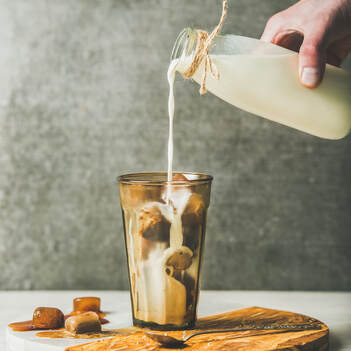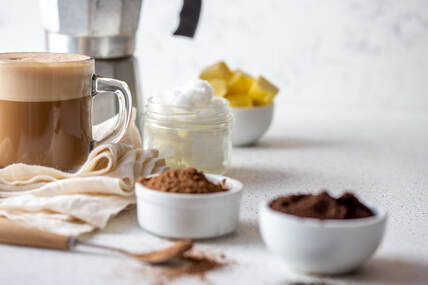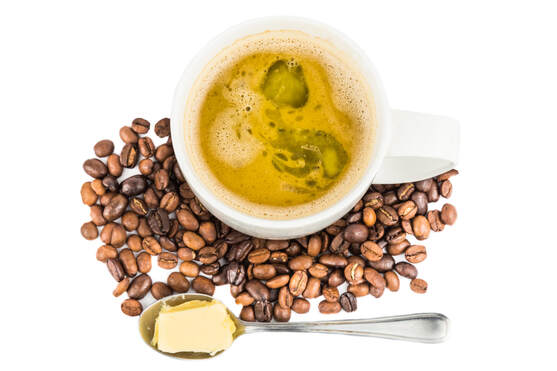|
We’ve made it to the final lap of our coffee marathon. If you’re just joining me now, you may want to read the previous blog posts on coffee, titled “Is Coffee Your Friend or Foe?” and “Coffee: How to Get the Most Bang Out of Your Cup”. If you’ve worked this hard to create an amazing beverage, it’s a good idea to add the highest quality goodies that fits your budget. Coffee is best consumed black, but for many, cream and sugar are mandatory additions. Let’s keep it simple by breaking “accoutrements” down into 3 different categories: cream, sugar, and oils.  Milk/Creamers This category includes all dairy and non-dairy liquids from cows, almonds, coconut, oats, soy, peas, and hemp. The protein content varies from animal versus non-animal and most are fortified with a decent amount of calcium and vitamin D. For some, adding a calcium-fortified liquid may be their only daily source of calcium. Regardless of origin, be aware that calcium absorption diminishes due to the tannin content in coffee. My first choice for most is a whole-fat organic milk; preferably raw, non-homogenized, and from A2 cows (I know that’s a bit of a stretch). Please choose organic if opting for animal-based products. If you’re avoiding dairy, any non-dairy alternative is perfectly acceptable, but go as unprocessed as possible. This means avoiding any odd ingredients and names you don’t recognize. A few points on alternative milks: 1) Choose organic soy milk; as conventional soy is always a genetically modified food and heavily sprayed with a potent, damaging herbicide called Roundup. 2) Non-dairy alternatives tend to contain thickeners and binders that can cause digestive issues. Pay close attention to how your body responds when consuming these products. Keep a sharp lookout for ingredients such as carrageenan, gums, flavorings, and “natural”. If you notice bloating, gas, and cramping you may have a food sensitivity or gut dysbiosis. The one type of creamer you may want to avoid all together are the highly artificial powders and flavored liquid creamers with a disturbingly, distant expiration date. Any product that fuses fat and a lengthy shelf life will eventually develop oxidized molecules, which cause a whole lot of inflammatory trouble in your body. These highly-processed, non-dairy creamers are loaded with unstable fats, preservatives, fillers, dyes, and artificial flavors. The fats often come in disguise as partially hydrogenated oil, palm oil, vegetable oils, mono and diglycerides, etc.. Choose simple ingredients that you recognize. If something appears uhhhhmazing…it likely isn’t (e.g. fat-free half-n-half). With just about everything, the less processed the better. The body doesn’t know what to do with these foreign molecules so don’t be surprised if your gut protests. Newsflash: You always want to avoid putting any kind of oxidized fat in your body. This is especially pertinent, if you have any heart or family history of cardiac disease. How is this related? Remember, the key to warding off chronic disease is to minimize oxidation of cells and inflammation.  Sweeteners It’s without saying that any type of coffee beverage that is blended with a pre-made mix or has the ending “chino” is going to be loaded with crack…er…I mean sugar. Unless you want to gain weight, induce massive amounts of inflammation, and disturb the delicate balance of your gastrointestinal and endocrine system; reducing sugar intake is always optimal. The exceptions are those that need quick fuel like hypoglycemic individuals, diabetics, athletes, and long-distance, exercise enthusiasts. But what about fake sugar? Hmmmm… this is a tough one and it depends on what you’re trying to do. If you’re a diabetic, then artificial sugar is the obvious option, but I would strongly encourage Stevia. Current research indicates that Stevia doesn’t elicit an insulin response like the alternatives. I never use artificial sugar and I simply keep it to 1-2 teaspoons of honey or organic sugar (it's also a GMO, highly sprayed food). It’s a very small dose and even if you’re watching your weight, it only adds 30-60 calories. Unfortunately, fake sugars potentially do more damage than good and I prefer to keep things natural. Please don’t use agave nectar as the fructose content is higher than high-fructose corn syrup. Unfortunately, it’s somewhat of a scam in the food industry.  Fats We’ve arrived at the most popular coffee trend since Starbucks. Bulletproof Coffee has induced oil-coffee mania that perfectly complements the low-carb craze of Paleo and Ketogenic diets. As if there isn’t a granule of sugar left on the planet, people are frapping up coffee concoctions made of butter, MCT oil, or coconut oil that provides a creamy, satisfying product. However, people may not realize that most commercialized MCT oil is more or less a specific extraction of palm or coconut oil. Coconuts are a better source but select organic, as toxic solvents are often used to extract the oil from the plant. Regardless, if you have any type of liver or gastrointestinal issues and/or navigating eating without a gallbladder; this might be a good option for you. For everyone else, one has to look at the total makeup of the diet and whether dumping this much fat in your body is serving you. Here are a few thing to keep in mind: -If this cup of oily brew is replacing your breakfast, then make sure you’re eating really well for the rest of the day. Coffee does lower the absorption of vitamin and minerals, which you need to replenish with a supplement or copious amounts of vegetables and fruits. This is especially important if you’re cycling on/off with intermittent fasting. - Watch your digestive system. You do need specific enzymes to break down fat. If you’re experiencing diarrhea, cramping, nausea, and vomiting, you’re likely ingesting more than your body can handle. You may need a digestive enzyme. - Do not use butter in your coffee unless it’s from organic, grass-fed cows. Toxins are stored in the fat of mammals. Grain-fed cows are likely ingesting mold, pesticides, and herbicides that are present in the feed. In addition, cows are also exposed to hormones and/or antibiotics. It’s all stored in the body of the cow and is transferred to you when ingesting animal fat and protein. (This is also why I suggest only organic, grass-fed, whole milk for creaming). Bottom line: Keep the sugar content low and the addition of “creaming” ingredients as natural and organic as possible. Well there you have it. All three blogs should provide you enough information on how to turn your cup of coffee into a superpower elixir. Our daily toxic exposure is tremendous (more than any of us care to admit). Rather than using all that antioxidant goodness to offset the toxins that YOUR choices are bringing into the coffee; use it to neutralize exposures that are out of your control, like air pollution. Check Out My Video On Artificial Sweeteners!
0 Comments
Your comment will be posted after it is approved.
Leave a Reply. |
AuthorShannon is a registered dietitian and functional nutritionist with a penchant for provocative topics, almond butter, and local theater. Archives
November 2019
Categories
All
|
Proudly powered by Weebly


 RSS Feed
RSS Feed